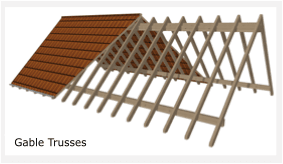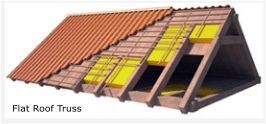Today, we will talk about the different types of roof trusses, components of roof trusses, the design of roof trusses, and many more things related to the roof truss. Firstly, we just discuss what is roof truss and what are the benefits of roof trusses.
What is a Roof Truss?
Roof trusses are made of straight beams formed into triangles, providing stability and allows for a variety of options when it comes to the region you want to cover. Roof Trusses are of high quality and we install more faster than other elements.
Also Read: What is Scaffolding? Components, Types, and Construction of Scaffolding
Nonetheless, roof trusses are those elements of lumber that are usually connected by the metal plates to form a web. However, the formation of the web will support a roof structure.
Benefits of a Roof Truss
- Buildings are encircled by the use of trusses. It also saves time at the working station and hence, prevents weather-related delays.
- Outward walls and many covers can be constructed without the formation of interior bearing walls, constructing one large, clear living space.
- This exposure supports entire ceilings and walls to be finalized with drywall plates, up to 1 foot in length, introduced uncut.
- Rough and finish flooring can be plopped over the full area. Cutting and fitting around enclosures are removed.
- The means of trusses to have large, clear lengths provides complete flexibility for the design of interior space, in line with the more advanced approach to constructing design. Enclosures under clear spanning trusses can be changed positions without risking the structural integrity of the building.
What are the main components of a Roof Truss?
The main components of a Roof Truss are as described below:-
Bearing
Most of the structural aid, usually a beam or wall, built by the building designer to hold up the truss reaction loads to the foundation.
Bottom Chord
An inclined, or horizontal member that stabilizes the bottom of a truss, usually holding up combined tension and bending stresses.
Cantilever
Component of a truss that lengthens beyond its aid, complete overhang.
Continuous Lateral Brace (CLR)
A line of continual structural elements to a chord or web member of a truss to lessen the laterally baseless length of the truss member. The CLR must be appropriately propped to stave off the concurrent lateral deformation and/or buckling of the procession of truss members
Heel
The intersection mark on the truss where top and bottom chords meet.
Overall Height
The vertical extent between the bearing and the uppermost point of the peak is called an overall height.
Overhang
Area of the top chord of a truss beyond the utmost of the bearing support.
Panel Length:
The horizontal distance between the centerlines of two continuous panel points along the top or bottom chord is known as panel length.
Panel Point:
The region on a truss where the web members and top or bottom chords bisect and are assembled by metal connector plates.
Slope/Pitch:
The inclination of the roof is depicted as inches of rising over inches of run.
Span:
The horizontal distance between the outside edges of exterior bearings is called span.
Splice:
The region where two chord members are assembled jointly to design a single member and usually occurs at a panel point or between panel points.
Top Chord:
The sloped member that establishes the top member of a truss is known as the top chord.
Triangulation:
The bond of forming rigid triangles with items adequately clamped together is known as triangulation.
Truss Plate:
Truss plates are made with steel preserved with zinc or zinc-aluminum alloy coatings. They are constructed to carry loads in wood.
Web:
The elements that will join the top and bottom chords so that it can form the triangular patterns in most of the trusses. It carries axial forces.
Wedge:
The triangular portion of lumber that has one side equal to the standard 2-inch dimension lumber widths, and is set between the top and bottom chords, usually to uphold the truss to the cantilever.
Also Read: What are the requirements of a good roof?
What are the most popular different types of Roof Trusses?
The type of roof truss we must choose for your construction project is an essential effect on the final development. Whether you’re constructing residences, multi-family undertakings, or large agricultural buildings, roof trusses are an essential fraction of the structure, style, and expense of your structure. It’s essential to select the right type of roof truss that suits your project and your project’s funding. Some of the most common types of roof trusses for your build are:
Gable Trusses
There is a huge variety of the trusses which were revealed into the gable or common truss category, including the Queen Post, Howe, king post, and Double Howe trusses. All of these four trusses are also implemented gable roof. These are also well known as a pitched or peaked roof, and however one of the most similar roof options in the US. The dissimilarity in each of these trusses has to do with the fabric in the truss itself. As you might think that the trusses like the Howe will provide more support than a King Post, and thus can be used for bigger buildings that may need more support.
The dissimilarity in each of these trusses has to do with the fabric in the truss itself. As you might think that the trusses like the Howe will provide more support than a King Post, and thus can be used for bigger buildings that may need more support.
Hip Truss
Another very similar roof type, that is the hip truss designed and used to create a hip roof, which has slopes on all four sides that occur to convene at a point amid the roof.
Hip trusses are especially widely useful for high wind and snowy areas, as they are better than gable roofs. Just similar to the gable truss lists, there are a various number of unique hip truss variations. We can use these types of trusses to make some different architectural styles.
Scissor Roof Truss
This kind of truss is well known for making the vaulted ceilings that today’s homeowners love.
Alternatively, the horizontal lower chords, a scissor roof truss has lower chords that slope upwards, making the peak for the ceiling.
Attic Truss
It is appropriate for buildings like sheds and garage that requires an additional storage space, attic trusses, which is also well-known for room-in-attic trusses, form both the ceiling and the floor truss for a room inclusion of a building’s attic.
These roof trusses occur with the support webs designed to frame the walls of the room. While these are most frequently used for structures with storage space, they can also be created for homes.
Mono Truss
A mono truss is similarly just one half of a full truss. These are very adaptable and can be further used to build a roof that permits for more sunlight and visual space.
They are even used in garages and sheds, as well as to make additional roof tiers and extensions to an existing roof.
North Light Roof Truss
It is very similar to the Double Howe Truss, the North Light Roof Truss which has a feature of the wide set of web trusses that creates triangles within the larger truss itself. A best-demanded choice for North Light Trusses and open floor plan homes are an old kind of truss that can span very large areas, like open concept homes and industrial buildings.
Flat Truss
As you expect before might, a flat truss is constructed for flat roofs. They are designed to build similarly to floor trusses, with the best deal of support, since they don’t feature slope to the shed precipitation or help maintain a load.
Flat roof trusses are most commonly used in commercial applications.
Gambrel Truss
The gambrel truss is most repeated and it is associated with barns. But it is also widely used in a variety of homes, now particularly used in the farmhouse style is increasing in popularity.
A gambrel truss is designed to bear a huge span and can add to the vertical area in a building due to its unique, tall construction.
Raised Heel Truss
The raised heel truss is the last truss we’ll cover today. Since these roof trusses are increased slightly and which is higher than other kinds of roof trusses.
They approve of simplified ventilation and plenty of rooms for insulation. This increases the heel trusses a go-to selecting for energy-efficient buildings.
Frequently Asked Questions
Why is a truss important?
In construction, trusses enable engineers to develop large open spaces with fewer materials. In both buildings and bridges, trusses are common because they are extremely strong. In most places wooden trusses are utilized with concrete, a material assessed much stronger than lumber.
Why are trusses physically stronger?
Moreover, trusses are physically stronger than other means of categorizing structural members. Because almost every substance can withstand a much larger load in tension or compression than in shear, bending, torsion, or other types of force.
What are the most common types of trusses?
The type of roof truss we must choose for your construction project is an essential effect on the final development. Whether you’re building homes, multi-family houses, or large agricultural buildings, roof trusses are an essential fraction of the structure, style, and expense of your structure. However, it’s essential to select the right type of roof truss that suits your project and your project’s funding.
Regardless, some of the most common types of roof trusses for your build are:
• Hip Truss
• Scissor Roof Truss
• Attic Truss
• Mono Truss
• North Light Roof Truss
• Flat Truss
• Gambrel Truss
• Gable Truss
What do roof trusses cost?
Roof truss installation typically costs between $7,200 and $12,000 for a 2,000-square-foot home. However, you need to pay anywhere from $1.50 to $4.50 per square foot of construction area for materials alone. Or you need to pay between $35 and $150 per truss, though very long and complex types can surpass $400 each.
How far can a roof truss span without support?
Usually, Trusses can span up to roughly 90′. Although very extended truss spans are more difficult to provide, erect, brace, and install appropriately.
Conclusion
The type of roof truss you are using for your construction projects might affect not only the aim of your buildings. But it can also affect the expense and the duration to construct.
Also Read: Complete Guide on Grades of Concrete









Leave a comment